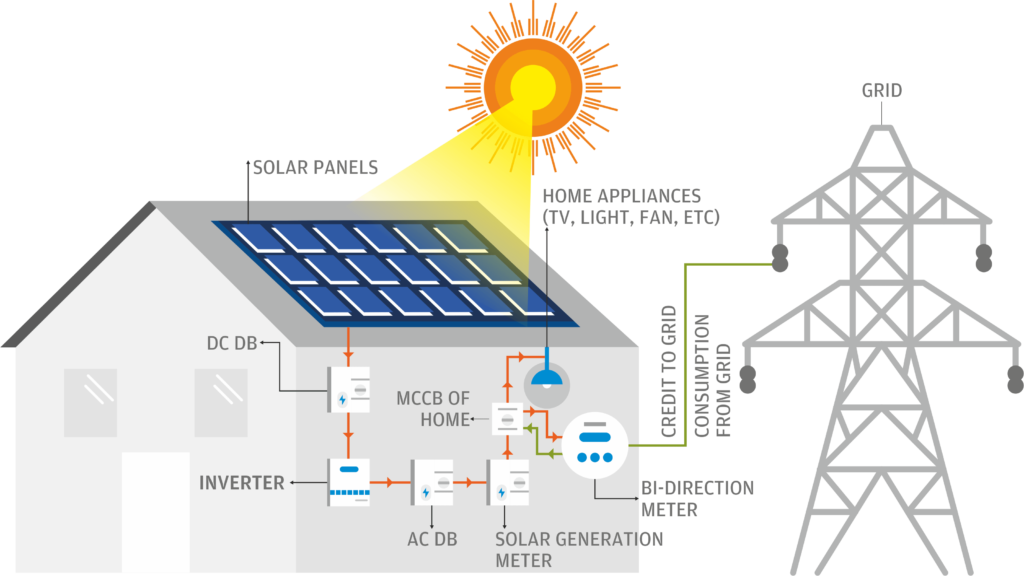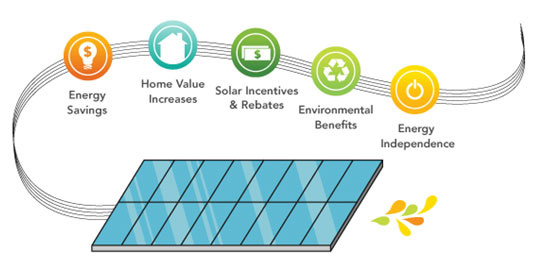Residential Solar Rooftops
These systems are typically installed on the rooftops of residential buildings, such as houses, apartments, or condominiums. They have become increasingly popular as homeowners seek to reduce their dependence on traditional fossil fuels, lower their electricity bills, and contribute to a cleaner environment.
- By generating their own electricity, homeowners can save money on their utility bills, especially over the long term.
- Solar rooftop systems provide homeowners with a degree of energy independence, reducing their vulnerability to fluctuating electricity prices.
- Rooftop Solar Power is often considered a long-term investment that pays off over time through electricity savings.
Residential Solar Rooftops Installation requirements
To install Residential Rooftop Solar Power, the following criteria need to be met:
- The dimensions and the structure of the roof are crucial for feasibility of Rooftop Solar Power Panels. The ideal scenario if solar panels should be installed facing the south.
- A minimum of 100 square feet area is required at the roof for installation of solar panels producing power up to 1KW.
- The standard equipment as per the norms of MNRE and Local DISCOM shall only be installed to avail subsidies or grid-connectivity.
- The consumer shall have 1 phase/ 3 phase supply service connection.
- A single Bi-Directional Net-Meter shall be installed for export and import of power

How it Works
- These panels are made up of semiconductor materials, typically silicon, which can generate a direct current (DC) electricity when exposed to sunlight.
- The solar panels capture sunlight during daylight hours. When sunlight strikes the surface of the solar cells, it excites the electrons in the semiconductor material, creating an electric current.
- The DC electricity generated by the solar panels needs to be converted into alternating current (AC) electricity, which is the type of electricity used in most residential homes and appliances. An inverter is used to perform this conversion. Inverters are typically installed near the solar panels or within the house.
- The AC electricity produced by the solar panels is used to power electrical appliances, lights, and other devices in the home. When the solar panels produce more electricity than the household consumes, the excess energy is sent back to the grid
ON-GRID/GRID-TIED/NET-METERING
- On-Grid Rooftop Solar power can actually reduce your monthly electricity bill! Since on-grid systems are incorporated with main grid supply, the power generated using solar energy during the day can be used and consumed by powering appliances and devices in homes as per the need. The excess solar electricity produced can be fed back to the grid. During night hours or cloud cover, the power can be drawn from the grid.
- The grid-tied solar systems work on Net-Metering technology. In such systems, a Bi-Directional electricity Net-Meter installed in your homes or residential complexes records the power used, excess power exported to the grid and power imported from the grid.
- If the electricity import from the grid, besides your power consumption from the solar electricity is more, you pay to the electricity board. But if the export of your solar power to the grid exceeds at the month-end, the board pays you the compensation.
- The On-Grid Rooftop Solar Systems allow use of grid supply when Solar Power is not able to generate required electricity – during night or cloud cover. Otherwise, you can easily consume power without using grid supply and thus cut down on your electricity expenses.
- Interestingly, this system can not only help you reduce your electricity bill but can help you earn money.
OFF-GRID
- Rooftop Solar Panels can either be grid-connected or off-grid. The ‘off-grid’ Residential Solar Rooftops are not linked to the main grid but with battery storage. The electricity generated by the solar panels is stored in the battery system attached to the panels. This stored electricity can then be used to operate household devices and appliances.
- The off-grid Solar Systems run by their own battery making it extremely reliable source of power. The main advantage of such a system can be advocated by the fact that it makes you independent of power cuts. Off-grid system comes to the fore during load shedding or when living in remote areas where power cut is quite frequent.
SLK manufactures, fabricates and procures all types of rooftop Solar Panels, Photovoltaic cells, Converters, Inverters, Mounting racks, Battery modules, Grids, junction boxes and other related devices using the world’s best technologies, which we have at our disposal all the time.
Fabrication: Solar structures, High raise structures, Railway and other related fabrication works
Advantages of Residential Solar Rooftops
- Renewable Energy
- Reduced Electricity Bills
- Energy Independence
- Environmental Benefits
- Long-Term Investment

Get In touch
(+91) 8978666741
available from 10:00 – 19:00
Address :- Survey no.15, Near Jyothi Milk, Suraram, Quthbullapur Mandal, Medchal Malkajgiri Dist. 55
Email:- srilakshmikarthikeyainfra@gmail.com

